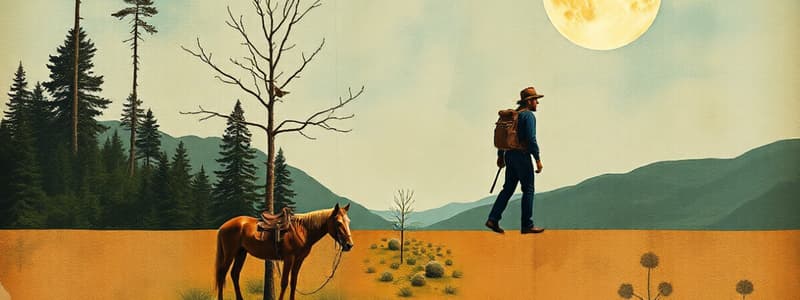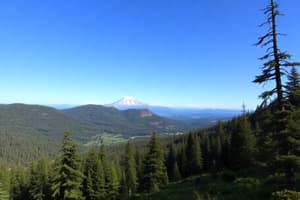Podcast
Questions and Answers
What does biocentric preservation emphasize?
What does biocentric preservation emphasize?
- The economic value of forests and rivers.
- The inherent rights of other organisms to exist. (correct)
- The aesthetic pleasure derived from landscapes.
- The utility of nature for human purposes.
Which stance did John Muir take in relation to Gifford Pinchot's views?
Which stance did John Muir take in relation to Gifford Pinchot's views?
- He sought a compromise between their philosophies.
- He supported Pinchot's utilitarian approach.
- He ignored Pinchot's views entirely.
- He opposed Pinchot's utilitarian approach. (correct)
What is the primary idea presented by Aldo Leopold regarding land?
What is the primary idea presented by Aldo Leopold regarding land?
- Land should be seen only as a financial asset.
- Care for the land is both a right and a practical necessity. (correct)
- We should exploit land for maximum economic benefit.
- Land ownership is an inherent human entitlement.
What did John Muir argue about the existence of nature?
What did John Muir argue about the existence of nature?
What key concept did Leopold introduce in his writings?
What key concept did Leopold introduce in his writings?
Which of the following national parks did John Muir help establish?
Which of the following national parks did John Muir help establish?
What is noted about the National Park Service in relation to Muir's philosophy?
What is noted about the National Park Service in relation to Muir's philosophy?
How did Muir view the relationship between humans and other organisms?
How did Muir view the relationship between humans and other organisms?
Flashcards
John Muir's Philosophy
John Muir's Philosophy
Muir believed nature has intrinsic value, regardless of its usefulness to humans. His approach emphasized aesthetic and spiritual value.
Biocentric Preservation
Biocentric Preservation
A philosophy emphasizing the inherent right of all living things to exist and pursue their own interests, as opposed to using nature solely for human needs.
Pinchot's Utilitarian Approach
Pinchot's Utilitarian Approach
This approach valued natural resources primarily for their economic benefit, often prioritizing logging, dam building, and other uses.
Yosemite and Kings Canyon National Parks
Yosemite and Kings Canyon National Parks
Signup and view all the flashcards
Aldo Leopold's Land Ethic
Aldo Leopold's Land Ethic
Signup and view all the flashcards
National Park Service
National Park Service
Signup and view all the flashcards
A Sand County Almanac
A Sand County Almanac
Signup and view all the flashcards
Study Notes
John Muir's Environmental Philosophy
- Muir strongly opposed Pinchot's utilitarian approach to natural resources.
- He advocated for the intrinsic value of nature, emphasizing aesthetic and spiritual values.
- Muir's perspective, called biocentric preservation, highlights the rights of all organisms to exist.
- He argued that nature's purpose extends beyond human use.
- He championed the protection of California's wild lands, including sequoia forests.
- Muir fought for Yosemite and Kings Canyon National Parks.
The National Park Service
- The National Park Service, established in 1916, prioritizes preserving nature.
- It was initially headed by Muir's disciple Stephen Mather.
- The Park Service often differed with Pinchot's utilitarian Forest Service.
Aldo Leopold's Stewardship Approach
- Aldo Leopold, a wildlife ecologist, practiced land stewardship.
- He restored a depleted farm in Wisconsin, planting trees.
- Leopold's work led to A Sand County Almanac.
- He argued that land should be viewed as a community, fostering love and respect.
- He proposed the "land ethic" as a moral imperative to care for the environment.
Studying That Suits You
Use AI to generate personalized quizzes and flashcards to suit your learning preferences.




